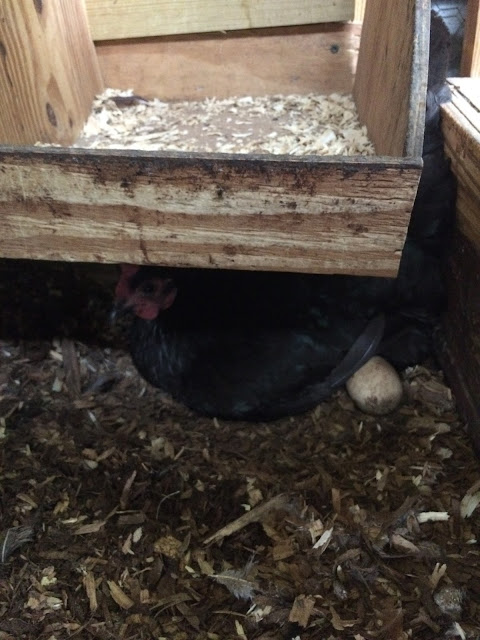A couple weeks later, I discovered I had two more broody hens in the main coop. So I thought I would extend my experiment a little farther.
For a day or so I let the two hens sit on wooden eggs to see how reliable they were. I moved one hen into the small A-frame coop with the mama hen and her chicks, but on a different end. I left one hen in the main coop. I had two objectives: to see if two broody hens could live in the same confined area and to see if a broody hen could protect chicks among grown chickens.
I made another trip to the farm store. This time I bought five Barred Rock, another breed I didn't have. These are black but with white and black wing feathers. I also bought five Leghorns. The chicks are solid light yellow, but will grow to be solid white chickens. Both breeds will be easily distinguishable from the others.
I put the chicks straight in with the hens, not bothering this time with a warmed area. The five Leghorns went to the A-frame coop and the Barred Rock went into the main coop.
I could tell almost immediately that the Barred Rock chicks in the main coop were going to struggle. There was just too much activity in there and it was disrupting the balance with all the chickens. I was afraid it would upset the production of eggs, too. The following morning one of the little black chicks had fallen down a crack and was dead. And the mama hen was out roaming, leaving her chicks to fend for themselves. So I moved them quickly to the A-frame with my good mama hen. She didn't even seem to notice I'd added a few more chicks. When you have eleven, what's four more?
The hen in the A-frame, supposedly looking after the five Leghorns, was doing a fair job looking after the chicks. But after a week or so, the two hens began to fight each other, both being protective over their chicks - which were mingling freely. I ended up moving her back to the main coop. This left my good mama hen to look after 20 chicks, which she did very easily. Once the chicks have plenty of feathers, they don't need the mama hen to keep them warm.
The conclusion to my experiment was that I had more success when I separated the broody hen from the main coop. The A-frame coop we have is perfect for this job because it has both a warm spot upstairs, and a safe and secure area on the ground for roaming as the chicks get older. All hens are different, but if you find a good mama, she can protect up to 20 chicks, especially when the weather is warm. I will definitely do this again when I am wanting more chicks.















That is one good mama hen!! @0 chicks. WOW!!
ReplyDelete